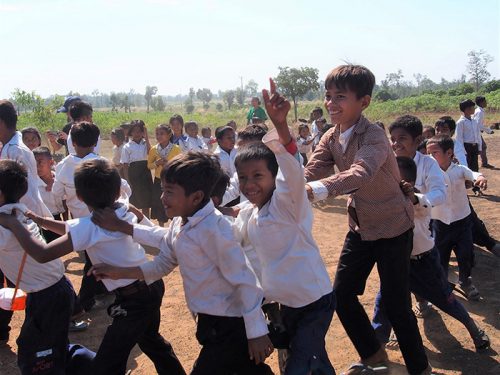Encountering the Issue of Landmines while Traveling
2021/1/22

Cambodia
It is said that each hour, one person in the world becomes a victim to landmines. Landmines are often thought of as a thing of the past, as many were buried decades ago, when civil wars broke out around the world. But once buried, mines remain there semi-permanently “until someone steps on them or removes them.” It is not uncommon that meeting someone on a journey leads you to trigger an new interest in the world. Opening your eyes to other realities, thinking about what you can do, and taking action are all parts of a cycle that Peace Boat offers through its programmes in Cambodia, one of the countries with the most affected by landmines. Through interaction with its people, we will learn the “now” of the landmine problem in Cambodia.

The problems surrounding Angkor Wat
Located in northwestern Cambodia, Siem Reap is famous for its world heritage site, Angkor Wat. Many hotels and restaurants line up, attracting tourists from all over the world. Even in such a gorgeous and vibrant landscape, you can get a glimpse of the scars of the civil war that this country experienced. In Cambodia, the civil war continued from the 1970s to the 1990s, and many people were killed. And now, while postwar reconstruction progresses and economic development progresses, there are many people suffering from poverty due to widening economic disparities.

The Pol Pot administration, which ruled Cambodia from 1975 to 1979 during the civil war, denied the culture and religion that Cambodia had cultivated so far, banned school education, and forced the people to move and work. He slaughtered numerous intellectuals, artists, teachers, religious figures, and those who opposed policy. The ruins of executions by the Pol Pot administration are called the Killing Fields, and more than 100 have been found in the country. One of them is in Siem Reap, where a temple is now built for requiescats and a memorial tower containing the remains found in this place. Materials that tell the history of the slaughter are exhibited, and it is a place to learn and think about the Cambodian Civil War.

20 years after the peace agreement
In 1991, when the peace agreement was signed, Cambodia began to move toward postwar reconstruction. Landmines buried during the civil war were one of the key challenges. Therefore, the “Cambodia Landmine Countermeasures Center (CMAC)” was established in 1993, and landmine removal started. Since then, CMAC has continued to deal with landmines and unexploded ordnance, train landmine removers, and educate people living in landmine fields to avoid danger. At the CMAC Peace Museum, you can learn more about Cambodia’s landmine problems by displaying photographs during the civil war, a large number of land mines, and unexploded ordnance. Vehicles that were wrecked by a land mine accident are also lined up, demonstrating the horror of land mines.

To the minefield
Landmine removal is performed by wearing heavy armor and a helmet under the scorching sun with a temperature of nearly 40 degrees Celsius. You can also tour the site on the tour. If the metal detector in your hand reacts, carefully dig the ground to see if the mines are buried. This is a dangerous task that could cause a land mine to explode if you make a mistake. Participants of the tour will also wear the same equipment as the remover for safety and observe how hard it is. It takes a lot of time and effort to clear landmines, but this is still the most reliable way to get rid of them. Eliminating one land mine saves one’s life and life.

Still, the victims of land mines are endless.
Prostheses are what the victims need after treatment in the hospital. The Siem Reap State Rehabilitation Center offers free prostheses. One victim said, “I will never forget the moment I stepped on a land mine, but being able to walk with an artificial limb gave me hope to live.” The local NGO Angkor Association for Persons with Disabilities provides vocational training to victims. Mr. Sowanta, the representative, told me about his thoughts when establishing an NGO. “I also lost both legs after stepping on a land mine and thought about suicide for a while, but when I saw other victims dying one after another due to hunger and illness, I decided to help.”

A “Village of Hope” where land mines are buried.
About 3 hours drive from the town of Siem Reap, you will arrive at the small village of Sunahai in the jungle. It is a new village created in 2005 when people migrated from all over the country. However, after migration, much of the land turned out to be minefields. Even so, the villagers say that this village is their hope. Even if land mines are buried, they were finally able to get their own land. By farming here, their families have become able to live. Peace Boat is helping the village clear landmines so that people can live safely. In 2016, an elementary school was completed on the land where landmines were removed. Peace Boat visits the school on a regular basis and continues to interact with the children.

A journey that leads to the future
The support that began in 1998 when Peace Boat met Cambodian people was the “100 Yen Campaign to Eliminate Landmines from Cambodia”. By the end of 2020, the campaign centered on street fundraising had helped remove more than 1,000 land mines and cleared from more than 2 million square meters of land. People are walking on the mine-free roads today. Peace Boat continue traveling through the years while cooperating with the local people. In Cambodia, I met people who are working hard to get rid of land mines. Interacting with them will then gave me the courage to take action.
